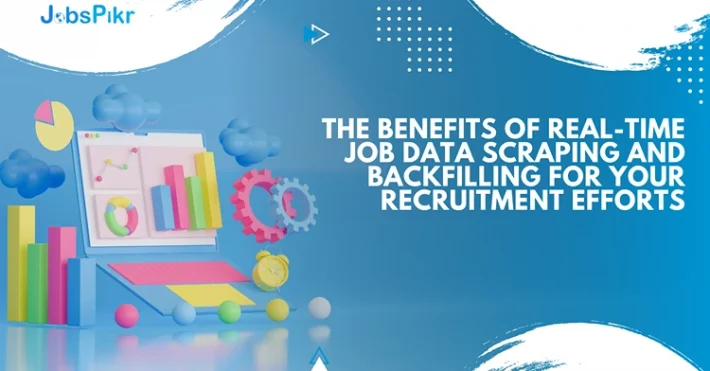Scraping job data in real-time and filling your database with different data points can be highly beneficial. These include job titles, salary details, skills required, years of experience needed, and more. Job Data Scraping can help in getting both current data and backfilling older data. Having the data for a longer timeline is advisable so that you can spot market trends and the impact of major global events on the job market.
What are the Benefits?
Scraping real-time jobs can enable your HR team to work more efficiently and make data-backed decisions. A centralized repository of all job data to date, which gets updated every second can work wonders:
Efficiency:
When using real-time job data to manage many of your processes like job post creation, or salary comparison, you would automatically be reducing a lot of manual tasks. Thus you can easily make do with a leaner team. Recruiters can also focus more on the decision-making processes and evaluation of the final results that come out of data.
Less error-prone:
Data-Backed Systems are likely to be less susceptible to manual errors or biases in decision-making. Automatically scraping a live job feed and adding it to your database and then running your latest problem statements on the database would ensure that you are always using the latest job market data for finding trends or solutions.
Completeness and accuracy of data:
Getting data from multiple sources enhances safety measures and ensures that unwanted biases don’t creep into the data. Having access to historical data on top of this helps paint a full picture. For example, someone just having the last 6 months’ data may not really understand how the job market works, as compared to one accessing the last 10 years’ data.
Wider Reach:
Backfilling of data along with real-time data capture would allow job boards or job sites to also gain access to a wider pool of candidates since they would have two major advantages on your platform–
- They would be able to see what type of candidates have historically been a good fit for certain positions.
- They will have a large pool of job posts to apply to.
Cost:
Automation that runs on live data instead of running DIY scripts periodically may seem to be more expensive initially but will save you money in the long run. This is through the quality and thoroughness of the data– which you will be able to bank on to create dependable data-backed products and solutions.
Competition Tracking:
Real-time job data scraping would allow companies to keep track of –
- Positions that are being advertised by competitors.
- Other companies offering the same positions as themselves.
- Differences and similarities in job posts for similar roles.
Better Recruitment Strategy:
A talent team that has access to data can plan ahead. They can invest time in strategic talent management so that the business and the ‘people-plan’ are in sync and at no point in time does the bottom line of the business suffer due to lack of talent or difficulty in finding the right talent.
Improved Candidate Experience:
Data-backed hiring processes are also smoother and faster and candidates are likely to prefer it over manual processes. Often job posts themselves have mistakes or unreal criteria. This can be avoided by using existing data for creating new job posts. It would enable more candidates to apply.
Dashboard and Notification Systems:
Events like the Covid Pandemic or the Great Resignation greatly affect the job market. Salaries change, the work culture evolves, and the entire dynamic shifts for certain industries. This is why having a finger on the pulse of the job market is crucial. If you have access to historical data as well as a live job data feed, you could easily set up a notification system and a dashboard to capture trends and detect anomalies or changes. The system would be able to detect things like an increasing number of hiring opportunities in a smaller city or more companies offering hybrid work options.
Single Source of Truth:
Having a database with complete job data at any point in time allows individuals from different departments to use it. For instance, the finance department may access the data to figure out how the company’s human resources spending measures against its competitors. As long as everyone is using the same data, the numbers would match, and collaboration and discussion would be more seamless.
Where do you get the data?
Job backfilling and job data scraping are tedious tasks especially when you are capturing data in real-time from multiple sources. You are likely to require all the tools associated with an enterprise-grade web scraping solution.
This would include–
- IP rotation.
- Ensuring the legality of scraping from each source.
- Updating changes in systems so that UI changes in source websites are handled.
- Running concurrent threads that would scrape data from multiple sources and push them down the same pipe every second.
- Cleaning data from different sources and storing them in a single central repository. Data from all websites may not be in the same format so some amount of data cleaning and normalization may be required.
- Setting up and maintaining the cloud infrastructure required for web scraping.
Taking up all of these tasks and more wouldn’t be feasible for most companies. And even if it was, companies shouldn’t lose focus on the main business problem by indulging in such challenges that have already been solved by industry stalwarts. Our team at JobsPikr provides one of the most popular AI-powered Talent Intelligence platforms that is used by corporates as well as Job Boards. Here you get access to both a live data feed and historical data. Special filters help you sift through the data so that you can consume only what you need.
Data access is also provided via different means so that integration with your existing systems is a breeze. API integrations or Cloud storage– either option is available so that you can save the data in any target resource and run your real-time queries however you want it. These features are likely to take you ahead of the competition as your HR team starts using job market data on a day-to-day basis.



